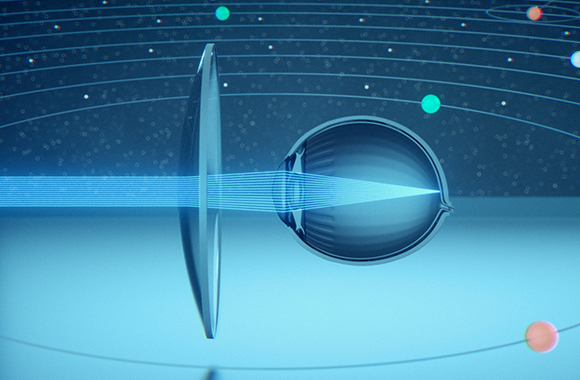Myopia Control Management
What is Myopia?

Myopia is also known as short-sightedness. Someone with myopia can see well up close, but not so well far away.
Optically speaking, myopic eyes are larger than the norm causing the rays of light to focus in front of the retina (the light sensitive layer of cells at the back of the eye). In simple terms myopia could be described as eyes that are too big.
What risks are associated with myopia?
Aside from needing glasses or contact lenses to see clearly, there are also some conditions that a person is more at risk of if they are myopic:
- Myopic maculopathy
- Retinal detachment
- Cataracts
- Glaucoma
The more myopic a person is, the higher the risk of these conditions developing

What is myopia control management?
Myopia control management is a name for any process that tries to limit how myopic a patient becomes. At Askew Eyewear, we offer two myopia control options:
- Misight Contact Lenses
- Stellest Glasses
Both methods are designed to help stem the eye growth. As myopia is caused by the eye being too big, if we are able to slow the eye growth then the myopia progression slows.
They work by creating “peripheral defocus†which is thought to help reduce the growth of the eye. This means the peripheral part of the lens gives the peripheral retina blurry vision. so the solutions can feel a little strange on first assessment, but children will typically adapt very quickly to this.
Stellest Myopia Control Spectacle Lenses
Stellest lenses have 1021 tiny “lenslets†in the periphery of the lens which cause peripheral defocus. The centre of the lens maintains good focus so the child can see clearly when looking directly at objects.
For maximum effect, they should be worn for at least 12 hours per day, 7 days a week.
*Please note this is not fully funded by the NHS currently, so private fees apply.

Misight Myopia Control Contact Lenses
Peripheral rings in Misight contact lenses help to focus light in front of the retina causing peripheral defocus. The centre of the lens maintains good focus so the child can see clearly when looking directly at objects.
For maximum effect, they should be worn for at least 10 hours per day, 6 days a week.
*Please note this is not fully funded by the NHS currently, so private fees apply.

Limitations of Myopia Control Management
It is important to realise that myopia control management does not cure or reduce myopia. It simply aims to slow down the rate at which it gets worse.
As these technologies are relatively new, the research studies that show their effects are predominantly funded by the manufacturers of the lenses. However the mechanisms of peripheral defocus reducing eye growth have been known for some time so whilst there is currently little peer reviewed evidence for these specific technologies, the underlying principles of peripheral defocus are more accepted within the eyecare professional communities. In time more peer reviewed evidence will emerge which we can discuss with you as it does.
Whilst manufacturers' clinical trials show a 59-67% reduction on average in the progression of myopia, we cannot guarantee that myopia management will definitely reduce the progression of child’s myopia.
There is a risk that when myopia control solutions are stopped, the myopia may begin to progress quickly. The older the child is when they stop myopia management, the lower this risk is thought to be.
